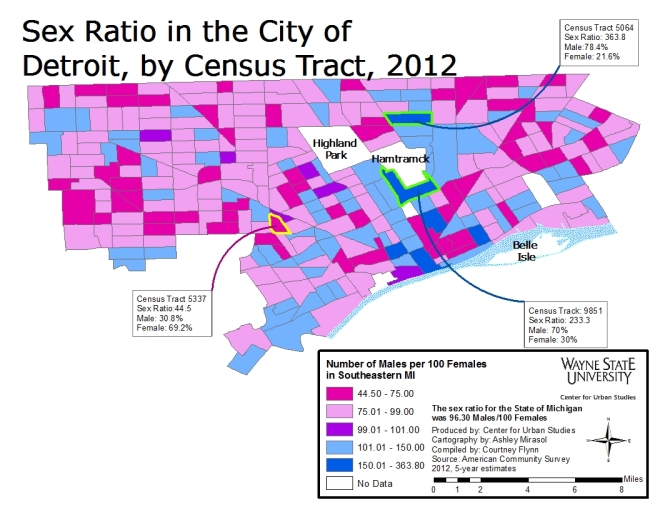In this post, we use American Community Survey data from 2012 to examine the male/female, or sex, ratios across Southeastern Michigan. A population’s male/female ratio is reported as the number of males per 100 females. In each of the seven counties in the region, and in a majority of the region’s municipalities, there were more females than males. There were, however, about three dozen rural municipalities where males outnumbered females.
In 2012, Wayne County had the highest percentage of females in the seven county region. The county’s population was comprised of 52 percent females and 48 percent males. This is the same as a male/female ratio of of 92.44, where there were 92.44 males for every 100 females. The city of Detroit, located in Wayne County, had an even lower male/female ratio; there were 89.2 males for every 100 females.
In the region, Livingston County was the closest to having the population equally divided between males and females. The 2012 male/female ratio was 99.83 males per 100 females. For this county that meant the population was almost exactly 50 percent male and 50 percent female.
There were several municipalities throughout the region with a male/female ratio that was either much higher or lower than that county’s average. For example, the small rural community of York Township in Washtenaw County had the highest male percentage in the region. York’s population was 59.2 percent male and 40.8 percent female. Lyndon Township, also located in Washtenaw County, had the second highest male population at 56.8 percent; 43.2 percent of the population was female. A majority of the municipalities with more males than females are located in the rural areas. One might speculate that these communities have many farmers who may be either widowers or single males.
Royal Oak Charter Township in Oakland County was the municipality with the lowest percentage of males in the region. The township’s population was 59.9 percent female and 40.1 percent male. Overall, Oakland County was 51.5 percent female and 48.5 percent male.
In the city of Detroit in 2012, there were 89.2 males for every 100 females. In the same year, there were also census tracts with disproportionate ratios of either males or females. For example, census tract 9851, which borders the city of Hamtramck, had 233.3 males per 100 females. This meant that 70 percent of the population was male and 30 percent was female. In tract 5064, north of Hamtramck, the ratio was even higher; there were 363.8 males for every 100 females. This meant that 78.4 percent of the population was male and 21.6 was female. The lowest ratio was in census tract 5337, where there 44.5 males per every 100 females; this also meant 69.2 percent of the population was female.


